Watermelon
BackWatermelon is the ultimate juicy fruit that hits the spot on a hot summers day. Lately it’s been given a bit of a makeover and is appearing in trendy salads teamed with fetta, pomegranate, rocket and onions. Onions I hear you say? With watermelon? Surprisingly, it works.
Watermelon is a cucurbit and belongs to the same family as pumpkins, squash and zucchini. Most watermelons have the same sprawling habit as their relatives so you’ll need plenty of space. There are however some compact varieties bred to suit smaller spaces and can be grown fairly easily in a big pot. So if you’re after something that’s fun to grow and that will interest the kids it’s time to plant a watermelon!
How To Grow Watermelon
Coming from Africa, watermelons love the heat. This means they need warm soils to germinate and grow and definitely do not like frosts. Choose a spot in the garden that has plenty of summer sunshine and room for your watermelon to spread. The soil should be enriched with compost and manure as well as an pelletised organic fertiliser. And finally good drainage is essential, so if you have a clay soil apply some gypsum at this point.
Seeds can be started off in small pots but remember germination is best when the potting mix is warm so put the pots somewhere that will capture heat eg against a north facing brick wall or on top of the water heater. Germinating in pots is a good way to get things going a bit earlier in the season and is very useful if you live in a cooler region. Plant out when the soils have warmed up and water in with OCP eco-seaweed. If the soil is still cool seedlings will just sit still and not grow. If there’s still a risk of late frosts listen to the weather reports and cover plants at night as required.
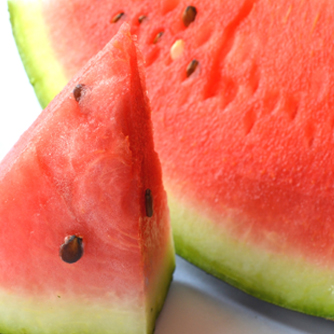
Ripe juicy watermelon
Alternatively seeds can be planted directly in warm soils. Sow 2-3 seeds together, leaving plenty of space between other groupings. Water in with eco-seaweed to stimulate germination. When seedlings emerge thin to the strongest 1-2 plants (depending on how much space you have).
Watermelons don’t like drying out and need regular, deep waterings to establish strong plants and develop sweet, juicy fruit. Be sure to mulch around plants to help retain moisture and keep away pesky weeds.
As the vines grow, pinch out the growing tips when they’re 1-2m long or once they’ve started flowering. This promotes side growth and helps limit their overall sprawl. As the fruit starts to develop, place straw or sugar cane mulch under the growing fruit to protect it from rotting on the soil. In extreme heat move nearby vines to cast shade on exposed fruit to prevent sun scald.
It usually takes several months before fruit is ready to harvest but there are some varieties which produce fruit a bit quicker. Either way the earlier you start the sooner you’ll be enjoying the sweet fruit!
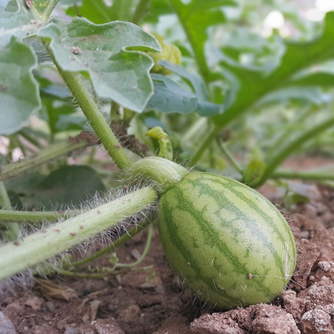
Growing watermelon
Sowing Guide for Watermelons
| Growing Zone | Sowing Time |
| Cool Zones | Spring |
| Mediterranean Zones | Spring, Summer |
| Warm & Temperate Frost Free Zones | Spring, Summer |
| Tropical & Subtropical Zones | Spring, Summer, Autumn, Winter |
Remember cool soils and frosts are the enemies of watermelon so bear that in mind when planning to sow seeds or plant plants. The above times are a guide only.
In cooler areas your growing window is pretty short so start seeds early in punnets indoors and select varieties which are fast maturing eg ‘Golden Midget’ or ‘Sweet Siberia’.
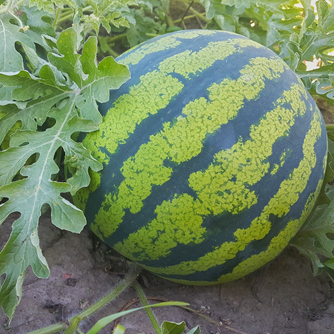
Almost ripe watermelon
Fertilising Watermelons
Watermelons are heavy feeders and you will get the best results from rich soil with regular fertilising. Every two weeks apply OCP eco-seaweed and OCP eco-aminogro to encourage bigger and better fruiting and help build up resistance to diseases.
Midway through the season you can boost the soil with a dose of dolomite and more compost/manure especially if the soil was poor to start with.
Pollination of Watermelons
Watermelons have separate male and female flowers with the female flowers producing the fruit. Pollination is carried out by bees visiting both and transferring pollen. It’s important to ensure plenty of bees are around so check out our tips on how to attract more bees or have a go at hand pollination. We’ve detailed how to do this on our cucumber page.
Harvesting Watermelons
Watermelons take a long time to mature (often 90 -110 days) and determining if the fruit is ready can be a bit tricky. If picked too early the fruit does not continue to ripen and will taste bland. Always check the underside of the fruit where it is touching the ground before harvesting. Unripe fruit will have a whitish spot but ripe fruit will have a yellow spot. Fruit should also sound hollow or ‘drummy’ when knocked with a closed fist. Cut the fruit from the vine with a sharp knife or secateurs.
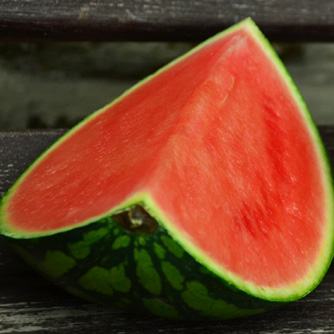
Seedless watermelon
Pests and Diseases of Watermelons
Unfortunately watermelons can have quite a few things go wrong. Here are the main things to watch out for:
- Aphids, whitefly and mites – this troublesome trio are the bane of every veggie patch but can be controlled with a horticultural oil. Spray at the first sign of trouble.
- Viruses – if you’ve got curling, mottled or yellowing leaves, stunted growth and/or reduced yields then it could be due one of several viruses. They're spread by sap sucking pests (eg aphids and whitefly) and can't be eradicated once infected so plants should be removed.
- Powdery mildew – this very common disease often strikes watermelons and spreads quickly. Spray with an organic fungicide and try not to wet the foliage when watering to minimise future outbreaks.
- Poor fruit set – can be caused by weather conditions like excessive heat, humidity or rainfall. Cool weather can also be to blame. Poor pollination is another reason so try to attract more bees or give hand pollinating a go.
- Fruit drop – dropping or shriveling of immature fruit could be due to poor pollination, fungal disease or dry soils.
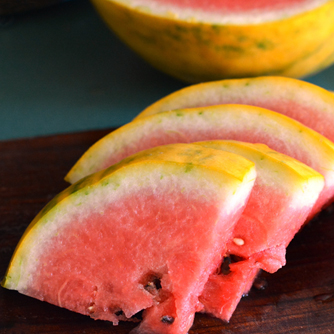
Unusual yellow skin watermelon
- Fruit cracking – internal cracks in the fruit can be caused by low temperatures when ripening. It’s most common in the large watermelon varieties so there might be a genetic factor at play. Fruit will still taste yummy
- Small fruits – caused by a lack of water or nutrients. Remember watermelons need plenty of both! Hard compacted soils can also be at fault so use eco-flo gypsum to improve aeration.
- Nematodes – stunted growth and lumps on roots indicates that tiny nematodes have attacked the roots. More commonly seen in sandy soils and hot climates. Apply OCP eco-nemguard at the time of planting and again every 4-6 weeks to control nematodes and allow plants to develop healthy roots. Boosting the organic content in the soil with compost and manures and practicing crop rotation can also help reduce nematode numbers.
- Other diseases – there are all manner of other diseases which can attack watermelons causing plant death, stunted growth or random spots/blotches/rotting on leaves and fruit. They are often difficult or impossible to control so you need to take preventative measures. Practice crop rotation in the veggie patch and remove infected foliage/plants early. Regular applications of OCP eco-seaweed and OCP eco-aminogro (especially to the foliage) will help keep plants healthy with the added bonus of extra growth and fruit!
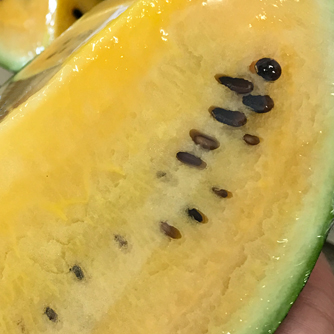
And a yellow flesh watermelon


